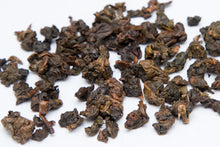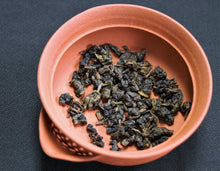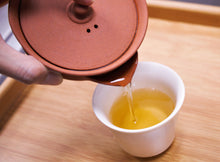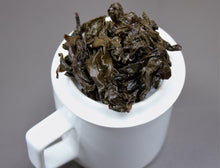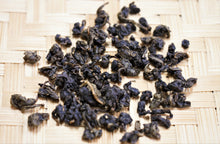
Mu Zha Tie Guan Yin is a traditional Taiwan Oolong Tea. Tea is well-baked with traditional charcoal fire. It has a complex and smooth acid-fruity taste, with a caramel-like aroma and a hint of dried fruity note, with no bitterness or astringent taste. The tea liquid has crimson color. It is matching well to serve with savory food, or to relax the body and mind after a hectic day.
 Mu Zha Tie Guan Yin originated from Northern Taiwan, Wen Shan District, Taipei City. According to the record, the tea plantation in Northern Taiwan started more than 300 years ago. During Qing Dynasty, around 1796 to 1820, record mentioned that tea tree was brought by a tea merchant named Ke Chao from Wuyi in Fujian and planted in Wen Shan District of Northern Taiwan. Wen Shan is not just today's famous tea production area, it is also the earliest birthplace of the Taiwan tea. About 200 years ago, Tie Guan Yin cultivar was brought from Anxi of Fujian and planted in Mu Zha of Wen Shan District. Thus, the Mu Zha is the earliest birthplace of Taiwan Tie Guan Yin. In the beginning, the tea tree was planted in Zhang Hu hill. Later in 1919, the two brothers of Zhang family, Zhang Nai Miao and Zhang Nai Qian brought back the tea trees from Anxi and started the plantation of Tie Guan Yin cultivar in a larger scale in Mu Zha.
Mu Zha Tie Guan Yin originated from Northern Taiwan, Wen Shan District, Taipei City. According to the record, the tea plantation in Northern Taiwan started more than 300 years ago. During Qing Dynasty, around 1796 to 1820, record mentioned that tea tree was brought by a tea merchant named Ke Chao from Wuyi in Fujian and planted in Wen Shan District of Northern Taiwan. Wen Shan is not just today's famous tea production area, it is also the earliest birthplace of the Taiwan tea. About 200 years ago, Tie Guan Yin cultivar was brought from Anxi of Fujian and planted in Mu Zha of Wen Shan District. Thus, the Mu Zha is the earliest birthplace of Taiwan Tie Guan Yin. In the beginning, the tea tree was planted in Zhang Hu hill. Later in 1919, the two brothers of Zhang family, Zhang Nai Miao and Zhang Nai Qian brought back the tea trees from Anxi and started the plantation of Tie Guan Yin cultivar in a larger scale in Mu Zha.

The Secret of Mu Zha TGY process
When we look at its dry leaf, each leaf is rolled-up firmly with dark brown color, unlike green TGY that dominating the market. Upon brewing, each leaf uncurls very slowly. You will notice its wrinkled surface. Traditionally, the rolling and baking process of Mu Zha TGY is different from other high mountain oolong tea. After the fermentation process, the leaves will undergo primary drying process to partially halt the oxidation of enzyme. The drying process is carefully managed so as not to completely dry the leaves. And then, the semi-dried leaves are bagged in a cotton bag and rolled to form a round-ball shape. This bag of tea leaves is then rolled for 20 to 30 times. In between the rolling, the bag is opened to remove the tea leaves and then dismantle the block of tea leaves, and then continue the bagging and rolling process. After a few rounds of bagging and rolling, the tea leaves already cool down. It's then place into the frying pan and re-heated at 70 to 80 degree Celsius before the next rounds of bagging and rolling is continued. After this series of process, the tea leaves are then undergone the second rolling and baking process. The tea leaves are heated to 70-80 degree Celsius and then it's rolled by hand. It's repeated for 10 to 20 times. This series of step are repeated for many times until the tea leaves are curled and tightly shaped. The tea components are converted into substances contributed to flavour and taste thanks to the roasting temperature.

Mu Zha Tie Guan Yin has a complex and smooth acid-fruity taste, with no bitterness or astringent taste. The tea liquid has crimson color.
Brewing Method
(1) Water
If you are using tap water, it is necessary to filter the water using an activated carbon filter. If not, you wouldn’t be able to enjoy the authentic taste of tea. Chlorine is added to tap water in order to sanitize bacteria. This chlorinated water will also harm our body cells. Concerning about our health condition, it is very important to remove chlorine from drinking water. The most effective method in removing chlorine is to install an activated carbon filter. This type of filter is designed for removing organic substance. It will remove not only chlorine, but also other harmful substance such as contaminated pesticide. The activated carbon filter can be easily obtained from the common hardware shop in most countries. If activated carbon filter is not available, please place a charcoal inside the water and leave it for over night. The material composed of activated carbon filter is made of ground charcoal. The difference is that activated carbon filter contains much finer particles and hence it has extremely large surface area for a better efficiency in filtration. We do not suggest RO water (reversed osmosis water) or distilled water. This water carries no mineral, the taste and flavor of tea tends to be very unstable, unless you have very superior quality tea and tea equipment.It is also advisable not to use fresh tap water. The intensity of after taste becomes stronger if water is kept overnight. Keeping water with stones or inside clay jar will increase the content of minerals. However, you need to confirm whether or not the water kept inside particular jar or with stone is suitable with your tea or tea equipment (such as teapot). If water jar carries certain minerals like copper or zinc, it will rather spoil the taste and flavor of tea. For this, you need to confirm with experiment on try and error basis.
For boiling water, please do not use aluminum or copper kettle. It spoils the taste of water. We suggest using kettle made of iron, stainless steel, tin or glass.
In the long run, you may observe a thick layer of scale accumulated inside your kettle. Our mother usually taught us to wash and remove it with citric acid. But please do not even try to remove the scale. Scale consists of minerals that exist in the water. The mineral composition is reflected from the water you used. If you remove the scale, the mineral ion balance between scale and water is destroyed. This balance is called buffer effect in science. The flavor and taste will seriously run out and you won’t be able to get previous taste and flavor for a long time. It is also important to stick to the same type of water whenever brewing tea. If source of water is changed, it carries different type of minerals. It will affect the mineral ion balance too.
(2) Quantity of tea leaves
To determine the quantity of tea leaves to be used, we divide the volume of water by 50. For example: the volume of teapot = 200ml; 200ml/50 =4g. You need to measure 4g of tea leaves for 200ml of water.
(3) Temperature
It is important to use boiling water. Please do not stop as soon as water is boiled. It is advisable to keep boiling for about 30 seconds to 1 minute.
(4) Brewing time
Based on the above ratio between hot water and the weight of tea leaf, the brewing time is as follow.
1st: 55 seconds
2nd 45 seconds
3rd 55 seconds
4th 65 seconds
5th 75 seconds
6th 85 seconds
Note: Please remove the lid while you are waiting for subsequent brewing. Tea leaf will be over steamed and get oxidized if the lid is not removed.
In order to enjoy oolong tea, always ensure that the water temperature is very hot. Use boiling water and rinse tea pot with boiling water to keep it hot.Storage of Tea
Keep tea away from moisture
Once a bag of tea is opened, please finish it within 3 months if you wish to enjoy its freshness. From the medical point of view, it is safe to consume the tea even if it is kept for a few years. However the freshness disappears if it is kept for too long. Tea must be tightly sealed before it is kept. Tea should be kept in ambient and dry conditions such as in the living room, but it must be completely away from humidity. Tea should not be kept in the kitchen as the environment is very humid. Avoid enclosed area such as inside the cupboard or drawer as these places are damp. Also avoid opening the bag of tea in humid atmosphere. It is recommended to open the bag during a sunny day or under air-conditioned atmosphere. Once tea leaves absorb moisture, deterioration of tea will be triggered within a few days. Tea will then give an astringent taste, sometime it tastes sour. The fresh aroma also becomes weaker.
Beware of keeping the tea in the fridge
The quality of tea lasts longer if it is kept in the fridge. However we strongly recommend you not to keep tea in the fridge. When tea is withdrawn from the fridge, there is usually condensation. Once tea is exposed to moisture during condensation, the quality will deteriorate within a few days. The higher moisture content in the tea leaves will trigger oxidation and it will completely destroy the quality of tea.
Here’s one frequently asked question: what happens if bag is sealed using tape or tea is packed in zipper bag and kept inside the fridge?
For your information, these simple sealing methods are not sufficient. When the bag is withdrawn from the fridge, it is cold inside the bag and therefore causes negative pressure. Air will be drawn from outside and condensation will occur. In addition, if the bag is taken in and out from the fridge very often, this will cause heat stress to the tea leaves as temperature is increased and decreased very frequently. If tea is kept in the fridge, when it is withdrawn from the fridge, it is necessary to leave it in ambient atmosphere for more than 24 hours in order to warm up the tea leaves. Based on our experience, 12 hours is not long enough. We may think tea is warmed up, but inside the bag, the tea leaves are still cold due to insulation effect.





